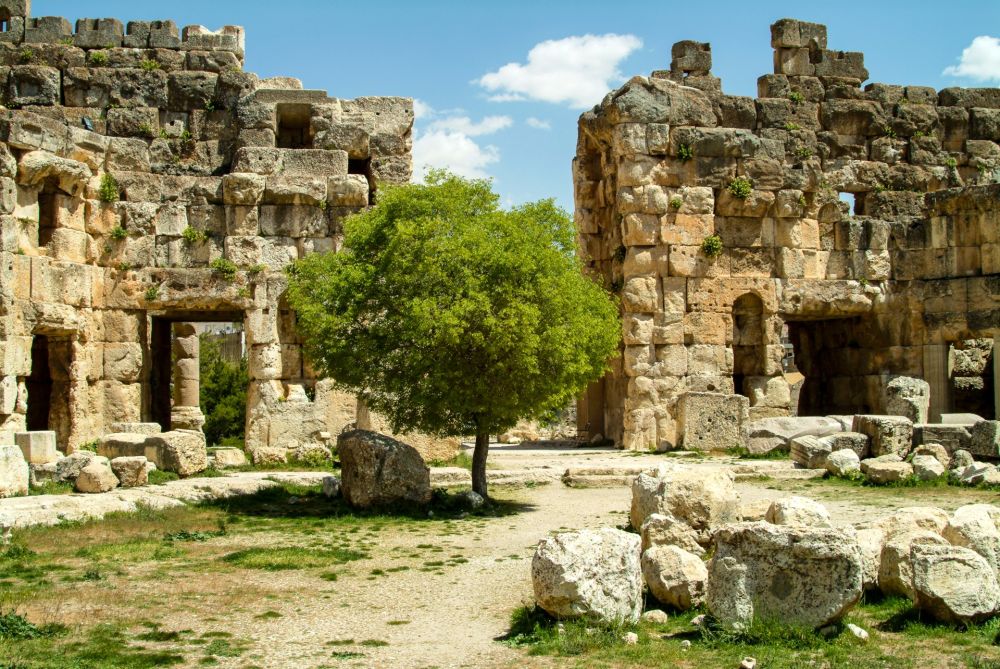Food History of The Hexagonal Forecourt, Baalbek Ruins, Lebanon
The Hexagonal Forecourt is part of the ancient city of Baalbek, a UNESCO World Heritage site in Lebanon. Baalbek, with its colossal structures, stands as a testament to the grandeur of Roman architecture. While there is no specific food history tied directly to the Hexagonal Forecourt itself, Lebanese cuisine in the region around Baalbek is deeply rooted in both history and tradition, bearing influences from various civilizations that have inhabited Lebanon over the millennia including the Phoenicians, Greeks, Romans, Ottomans, and French.
Lebanese cuisine is characterized by an abundance of grains, fruits, vegetables, fresh fish and seafood, and a limited use of meat. Since the forecourt is a part of historical ruins, you would not find food within its confines. However, the surrounding region reflects the rich culinary traditions with local ingredients like olives, wheat, chickpeas, and dairy products being central to their dishes, with various preparations that have been passed down through generations.
Top 10 Must-Try Food Dishes Around The Hexagonal Forecourt, Baalbek Ruins
- Tabbouleh (Veg) - A refreshing parsley-based salad mixed with tomatoes, onions, bulgur (cracked wheat), lemon juice, and olive oil.
- Hummus (Veg) - A creamy dip made from mashed chickpeas, tahini, garlic, lemon juice, and olive oil, usually served with pita bread.
- Baba Ghanoush (Veg) - A smoky eggplant dip mixed with tahini, garlic, lemon juice, and various seasonings.
- Fattoush (Veg) - A Levantine bread salad made from toasted or fried pieces of pita bread combined with mixed greens and other vegetables.
- Falafel (Veg) - Deep-fried balls or patties made from ground chickpeas or fava beans, often served in pita or with salad.
- Manakish (Veg) - A type of Levantine pizza, typically made with dough topped with thyme, cheese, or ground meat.
- Kibbeh (Non-veg) - Lebanon's national dish, which is made from ground lamb or beef mixed with bulgur and spices, and can be served raw, baked or fried.
- Sfiha (Non-veg) - Open-faced meat pies typically made with lamb or beef and topped with tomatoes, onions, pine nuts, and spices.
- Grilled Halloumi (Veg) - A semi-hard, unripened, brined cheese made from a mixture of goat's and sheep's milk, often grilled or fried.
- Mujadara (Veg) - A dish made with lentils and rice, topped with caramelized onions. It is a staple in the Lebanese diet and represents a hearty vegetarian option.
Top Restaurants Near The Hexagonal Forecourt, Baalbek Ruins
- Palmyra Restaurant
- Address: Baalbek, Lebanon
- Famous for: A variety of traditional Lebanese mezze, primarily vegetarian and seafood dishes.
- Lebanese Flower Baalbeck
- Address: Baalbek-Hermel Governorate, Lebanon
- Famous for: Traditional Lebanese cuisine, including the famed Tabbouleh (Veg).
- Sanabel Al Fakhara
- Address: Ras El Ain, Baalbek, Lebanon
- Famous for: Its grilled meats and Kibbeh (Non-veg) offerings.
Please note that access to eateries directly at the ancient site would be limited due to the historic nature of The Hexagonal Forecourt. However, the local town of Baalbek and the nearby city of Zahle offer a range of culinary experiences that showcase Lebanon's rich gastronomic heritage.

